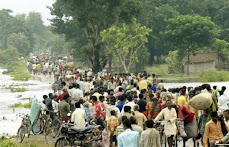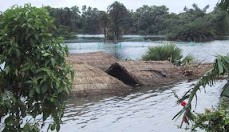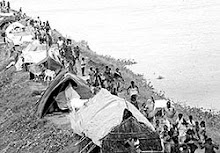Kosi’s chilling history: No lessons ever learnt
Inder Malhotra
WAY BACK in 1953, I had the privilege of accompanying Jawaharlal Nehru to Bihar. In those days, within the country, the Prime Minister travelled by an IAF Dakota. Even so, he decided to increase the number of journalists in his party from two to six, the additional four being foreigners, in equal strength from the two power blocs. The cause of the visit was intensely grim and he obviously wanted the outside world to witness it. Kosi, then called Bihar’s "river of sorrow", now renamed "river of misery", had wrought havoc — though it would have paled in comparison with this year’s catastrophic floods.
For four days, by plane, rail and car, Nehru visited as much of the ravaged areas as possible, offering solace to the sufferers and issuing terse instructions to officials in charge of rescue, relief and resettlement of those whose worldly possessions had been washed away. On his way back to Delhi, he told us that basically the tragedy was a natural disaster about which nothing could have been done. But, he hastened to add, that man’s contribution to nature’s fury, in terms of lack of imagination, competence and even compassion, together with lackadaisical action, was "more than considerable." He also said that since Kosi flowed from Nepal into India, the two countries would take steps jointly to control the floods.
Judging by what the luckless seven districts of the state have gone through since August 18, it seems that little has changed in 55 years. Or else there would not have been the plethora of complaints about the "tardiness" and "inadequacy" of the governmental and administrative response to a tragedy of huge magnitude. This despite the fact that between 1953 and the start of 2008 there have been several devastating floods caused by the same wayward river.
According to several reliable reports, neither Patna nor New Delhi were fully aware of the flood’s frightening dimensions. At the Centre, precious days were wasted in the mistaken belief that the recently-established Disaster Management Board would be able to deal with the problem. Only when the error became manifest was the Army called in and naval boats and divers mobilised. Even then, the relief effort was far from satisfactory. There was a constant lament about the shortage of boats. The other side of the same coin was that in several cases, families precariously perched on the roofs of their flooded huts, simply refused evacuation.
Most people may have forgotten that during the Emergency there was a terrible flooding of a coalmine at Chasnala, also in Bihar, in which a large number of miners had to fight for their survival in the deluge. The country did not have a pump powerful enough to draw out water from that depth. Eventually, the Soviet Union flew out one, and many lives were saved. Surely, India does not lack motorboats except that they are spread out at myriad places. Could they not have been requisitioned and flown to the submerged region? The story goes that at the height of the tragedy, some in New Delhi were planning to buy motor-engines to fit on locally available boats.
This depressing state of affairs was aggravated by the apparently deathless blame game. That between the Union and the state government — the former accusing the ministry in Patna of "ignoring the warnings" and the latter accusing the former of failing to provide "timely help" — can be treated as an inescapable part of the Indian system. Far more destructive is the blame game between this country and Nepal.
Ramaswamy R. Iyer, a former Union water resources secretary and an assiduous scholar of water-related problems, has summed up the situation succinctly, if also rather mildly. "The India-Nepal relationship," he says, "has been badly mismanaged on both sides. Ham-handedness and insensitivity on India’s part, and excessive touchiness and readiness to misunderstand on Nepal’s part, have combined to create a convoluted and volatile relationship which resists repair." This should explain why the 1954 Agreement on Kosi and the 1960 one on Gandak continue to be a source of resentment in Nepal even though both agreements were later amended to meet Nepali concerns. To make matters worse, the crucial Mahakali Agreement remains a dead letter to this day. No wonder, Mr Ramaswamy wants to "wipe the slate clean and start afresh." It is to be hoped that South Block and Nepal’s new Republican government share this approach. From this point of view, the visit to Delhi of Nepali Prime Minister Prachanda is timely.
Interestingly, despite the exchange of acerbic and heated rhetoric between Nepal and India, there is conspicuous agreement between the water experts in both countries. For instance, Nepal’s Deepak Gyawati fully agrees with Mr Ramaswamy and several other Indians that the Kosi Barrage, badly breached by gushing waters, should never have been built, and that embankments built to control the flow of Kosi have done more "harm than good". On these highly technical matters I can offer no opinion except that the government must examine them expeditiously and having taken decisions ensure that these are implemented more earnestly than has been the case so far.
Some have pertinently drawn comparisons between the admirable efficiency with which all agencies concerned in Tamil Nadu coped with the tsunami disaster of 2004 and the wailing and whining that has greeted the manner in which Kosi’s challenge has been met in Bihar. A retired civil servant commented that in Tamil Nadu, during the tsunami crisis, collectors of all affected districts waded through waste-deep water every day. He doubts if anything comparable happened in Bihar that was once among the best administered states but is now among the worst.
Remarkably, it was a Bihar civil servant who said that a precise code exists since the British days according to which it is the bounden duty of district authorities to strengthen the embankments before every monsoon but nobody pays it any heed. However, why blame collectors of Madhepura and other Bihar districts when the much-pampered Municipal Corporation of Delhi miserably fails to clean up the drains before monsoon and lets the nation’s capital to be waterlogged year after year?
The Asian Age, Sept 18, 2008
Historically, floods and their control have never been a big issue in the Ganga-Brahmaputra basin, as it is today. Floods became a major issue after the British occupied India. When they examined the Ganga basin, they believed that if it could be made “flood-free”, they could levy a tax in return for such protection.
Monday, 22 September 2008
Subscribe to:
Post Comments (Atom)








No comments:
Post a Comment